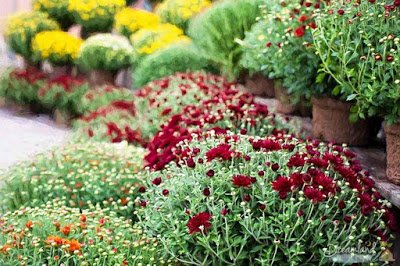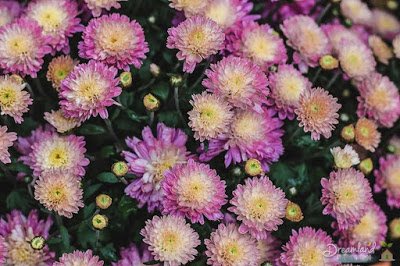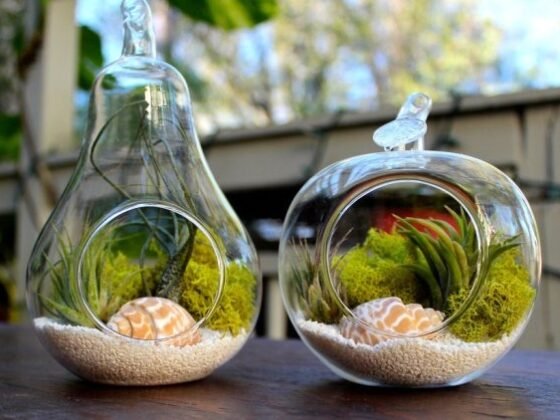Table of Contents Show
 |
| How to Grow and Take Care of Mums |
About Mums
The Chrysanthemum genus, better known as mums, is comprised of about 200 flowering species. They have deeply lobed leaves, and their size ranges from 15cm to 2m. Flowering colors include white, pink, red, yellow, green, purple, lavender and orange.
Flower shape for these species is quite varied; some species have blooms resembling daisies (C. morifolium), while others have tightly packed flowers with petals curling inward (C.Yoakiko) or outward. They also flower in diverse sizes. Mums’ flowering period spans from late spring to late fall depending on the species.
Most are perennial, and in colder climates they are treated as annuals. Knowing how to grow mums is a matter of supplying the right soil, light, and water requirements. Pruning these plants back will also promote optimal growth.
How to Grow and Take Care of Mums
Soil Requirements and Fertilization
Given the range of species, mums are suited for flower beds, the rock garden(C. haradjanii) or containers. They require light to slightly compact soil. The earth should have a slightly acidic pH and should be provided with sufficient organic matter, such as worm compost or aged manure.
Mums are resentful of wet feet, therefore the soil should drain well. This is particularly important for container growth. When growing in containers, use a water soluble fertilizer with slightly higher N (nitrogen) content every other week during the spring, switching to one with a higher P (phosphorus) and K (potassium) content in mid-summer.
In a flower bed use a slow release N-P-K fertilizer once the plants are well established after transplant into the ground and new growth has started. Use 10-20-15, and apply 40 to 50g per square meter. Plants should only be mulched if the soil drains well, and never mulch around the base of the plant.
Light Requirements
Mums fair exceptionally well in full sun; this is how maximum blooms are obtained. Although some species do well in partial shade, blooming is somewhat reduced. Should you plant them in partial shade, try to plant somewhere where shade occurs midday, or on the hottest hours of the day. Mums may also do well with only three hours of direct sunlight, as long as there are no overhanging trees, plants, or anything that would block some of the sun’s rays.
Most Crysanths flower in the fall. This is because they are light sensitive; flowering is induced as the daylight wanes and the night increases. Taking this into consideration you should avoid areas where there are night light sources. These will interfere with the plant’s cycle, and blooming can be greatly affected.
Water Requirements
Mums, as already mentioned, do not develop well with wet feet. Some species may tolerate short dry spells during the vegetating phase. These vibrant flowers benefit greatly from regular watering during their growing season and flowering. During summer and the hottest period of the year you can water up to three times per week. It is very important not to over water mums — if the soil is moist do not water. Irrigate them just as the soil starts to dry.
If in your climate zone mums overwinter well outdoors, do not water during this time of the year. Resume your watering after the last frost has passed.
Pruning
Knowing how to prune correctly is important to grow mums successfully. Early blooming mums (spring and summer) should be deadheaded unless you want to collect seeds, as some species may yet provide you with another flowering period in the fall.
Fall blooming Crysanths should be pinched in late spring. Just grab with your forefinger and thumb and “pull” out the end of each shoot. This will produce far more compact bushes with a greater flower density. Do this until mid-summer only, as you risk pinching away developing buds.
If your mums overwinter outside, all dead flowers, stems, and leaves should be removed before the first expected frost.
 |
| Keeping Garden Mums in Bloom Longer |
Keeping Garden Mums in Bloom Longer
Garden mums typically start out as beautiful displays of fall color but quickly turn brown and stop blooming. If your mums never reach their full potential, here are some tips that will help you choose healthy plants and keep them that way.
Chrysanthemums, which are also commonly called mums, are one of the most popular fall flowers due to their yellow and orange colors. Whether planted in the ground or in garden containers, many people struggle with keeping their mums looking good. Here are some tips on how to keep garden mums blooming longer.
Buy the Right Mums
While most southern states can grow any variety of mums, those in cooler northern climates should choose a variety that is cold hardy. These Chrysanthemum flowers will typically have the words “Cold Hardy” on their plant tags.
In addition to cold hardy varieties, there are early, mid and late blooming varieties of mums. If you are purchasing multiple potted mums for a front porch or for fall landscape decorations, choose several varieties so that you will have continuous blooms.
Pick a Healthy Mum
Once you have decided on the right variety based on your growing region, you need to pick a healthy plant that will last a long time. First look for large mum plants that have moist soil in the container. Chrysanthemum flowers do not like to have dry soil and if the soil is dry the mum may already be damaged. In addition, look for mums that have the most closed flower buds but the least amount of open flowers. These plants are not as far along in their growth process and will naturally bloom longer.
 |
| Mums, Chrysanthemum, Floral, Blossom |
Provide the Proper Care
One of the biggest mistakes that mum owners make is treating the plants like short-term decorations rather than potted plants. You can greatly extend the blooming period of mums if you keep the soil watered at least once per day. In addition, apply a liquid plant fertilizer to the soil immediately after planting and once per month thereafter. This is especially important if you plant the mums in a plant pot that previously contained summer flowers, since the previous flowers most likely used most of the soil nutrients.
Finally, keep mums more attractive and blooming longer by deadheading them daily. Deadheading means that you pinch off the blooms of the Chrysanthemum flowers that have started to fade and turn brown. This redirects water and soil nutrients to the parts of the mum that can develop new blooms.
Protect Mums from Cold Temperatures
Another challenge that will stop mums from blooming is cold temperatures. Mums prefer nighttime temperatures of 60 degrees so when the temperatures fall below this you must protect the plants. If the mums are potted, bring them indoors or into a garage at night. For ground planted mums or larger planters, cover them with clear plastic before nightfall and remove the plastic the next morning.
Now that you know how to keep garden mums blooming longer, you will have beautiful plants instead of green foliage with no flowers. Your beautiful blooming chrysanthemums will be the centerpiece of your fall landscaping.
References
- University of Missouri Extension, “Care of Flowering Potted Plants” – http://extension.missouri.edu/publications/displaypub.aspx?p=g6511










